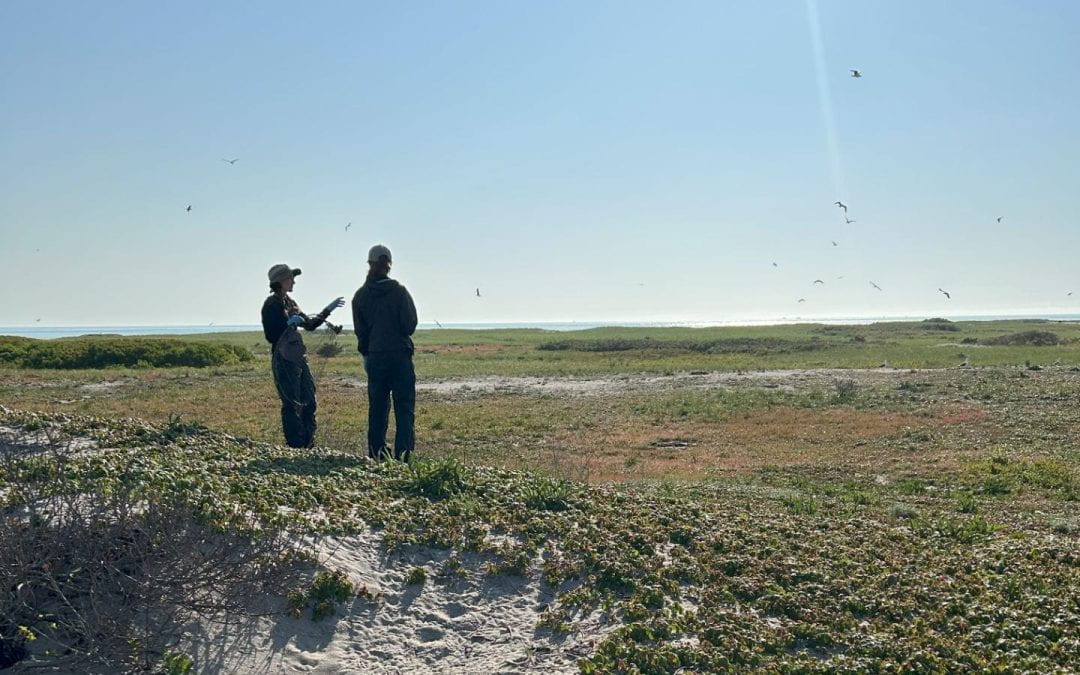The Thorne Lab is working on a collaborative project with several institutions along the east coast, and led by Duke University, called Wildlife and Offshore Wind (WOW) that is investigating the impact of offshore wind development on marine wildlife. Recently, we began field work focused on assessing seabird movement and behavior before and after offshore wind farm development. This June, we led tagging efforts of Great Black-backed gulls on the island of Muskeget, just west of Nantucket, MA. The tagging team consisted of the Thorne Lab’s PhD students, Kim Lato and Esther Nosazeogie, as well as Julia Gulka, a marine biologist with the Biodiversity Research Institute (BRI), a collaborator on the project. We successfully deployed 16 solar powered GPS tracking devices on breeding great black-backed gulls and will be tracking their movements over the next few months.
Esther, one of the newest member of the Thorne Lab, writes of her experience on the island, conducting gull field work for the first time:
After the trip from Long Island that involved around 6 hours on the road, and 3 hours on the water, we were greeted by the most populous residents of Muskeget Island: Gulls. Great black-backed (and some Herring) gulls ushered our boat onto the island with calls that could sound like a helpless baby or an aggressive but hapless old woman (who couldn’t stop intruders but was trying anyway), depending on the tempo and intensity. Those intelligent birds probably knew what we had come for.
Then we began to catch up on a year’s worth of CrossFit. We started with weight-lifting. We lugged supplies up the beach, set up camp, and took a breather to plot against the birds. Actually, we came for one species: the Great black-backed Gull, so we optimized our strategy accordingly.
We started carrying out our plot. It was the end of the egg-laying/chick-rearing season, and we had to find the nests of those birds which had waited until the end of the season to lay their eggs. We then ensured the eggs were viable (and the parents would come and sit at some point), and that was where the real work began. We set up bownet traps over the nest, taking the slope of the ground into account to avoid the nuisance effects of the laws of physics and replacing real eggs for dummy ones to avoid any collateral damage.
After that, it was time for the fun part, hide and seek: I see you (bird) but you can’t see me (human). And when we won the game, we pressed the trigger that released the net. Then we started the second part of the CrossFit training: sprinting like our lives were in danger. Actually, the running was for the bird’s life: understandably, a bird can get stressed trapped under a net, and we want to minimize the amount of time the bird is under stress. The finish line for the sprint was the captured bird and two of us worked together (armed with cut-proof gloves and shatter-proof glasses) to wrangle the bird to some semblance of quiet and safety. Then we carried the bird back to the processing station where the third person had been getting the materials/tools ready.
For starters, we covered the bird’s eyes with a sock to induce the bliss of oblivion and reduce stress. Then we gave the bird a GPS tag, attached in a similar design as a backpack (which sends GPS waypoints through the cell network to tell us where the bird is going). We measured the bird, and took samples of blood, feathers, and guano/poop (if the bird was feeling generous) Finally, we gave the bird a thank you bracelet (really, it was a federal identification band that wraps around the bird’s ankle), and let it go.
This process was repeated 15 more times over the next couple of days. In summary, the camping trip on Muskeget (while this tagging was done) was an experience in the economy of time, heat, energy, and infrastructure. It involved lots of running, quick meals, instant food, and abundant space for contemplation.”


